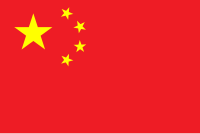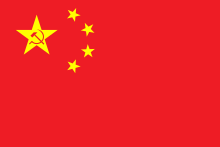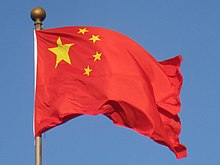Flag of China
 | |
| Name | 五星红旗 (English: "Five-star Red Flag") |
|---|---|
| Use | Civil and state flag, civil and state ensign |
| Proportion | 2:3 |
| Adopted |
|
| Design | A large golden star within an arc of four smaller golden stars, in the canton, on a field of Chinese red. |
| Designed by | Zeng Liansong |
 Variant flag of the People's Republic of China | |
| Use | War flag and Naval jack |
| Proportion | 4:5 |
| Adopted | 15 June 1949 |
| Design | A Chinese red field with a yellow star and Chinese numerals "八一", referencing August 1, at the canton. |
| Flag of China | |||||||||||||||||||
|---|---|---|---|---|---|---|---|---|---|---|---|---|---|---|---|---|---|---|---|
| Simplified Chinese | 中国国旗 | ||||||||||||||||||
| Traditional Chinese | 中國國旗 | ||||||||||||||||||
| Literal meaning | State flag of China | ||||||||||||||||||
| |||||||||||||||||||
| Flag of the People's Republic of China | |||||||||||||||||||
| Simplified Chinese | 中华人民共和国国旗 | ||||||||||||||||||
| Traditional Chinese | 中華人民共和國國旗 | ||||||||||||||||||
| Literal meaning | State flag of the People's Republic of China | ||||||||||||||||||
| |||||||||||||||||||
| Five-star Red Flag | |||||||||||||||||||
| Simplified Chinese | 五星红旗 | ||||||||||||||||||
| Traditional Chinese | 五星紅旗 | ||||||||||||||||||
| |||||||||||||||||||
The flag of China, officially the National Flag of the People's Republic of China, also known as the Five-star Red Flag,[2] is a Chinese red field with five golden stars charged at the canton. The design features one large star, with four smaller stars in an arc set off towards the fly. It has been the national flag of China since the foundation of the People's Republic of China on 1 October 1949.
The red represents the Chinese Communist Revolution and the five stars and their relationships to each other represent the unity of the Chinese people under the leadership of the Chinese Communist Party (CCP). The flag was first hoisted by the People's Liberation Army (PLA) on a pole overlooking Beijing's Tiananmen Square on 1 October 1949, at a ceremony proclaiming the establishment of the People's Republic of China.[3]
History[]
Early flags[]
The previous flag of China was the "Yellow Dragon Flag" used by the Qing dynasty — the last imperial dynasty in China's history — from 1862 until the overthrow of the monarchy during the Xinhai Revolution. The flag that was adopted in 1862 was triangular, but the dynasty adopted a rectangular version of the dragon flag in 1889.
Republic of China[]


The canton (upper corner on the hoist side) originated from the "Blue Sky with a White Sun flag" (青天白日旗; qīngtiān báirì qí) designed by Lu Haodong, a martyr of the Xinhai Revolution. He presented his design to represent the revolutionary army at the inauguration of the Society for Regenerating China, an anti-Qing society in Hong Kong, on 21 February 1895. This design was later adopted as the KMT party flag and the Coat of Arms of the Republic of China. The "red Earth" portion was added by Sun Yat-sen in the winter of 1906, bringing the flag to its modern form. According to George Yeo, the then Foreign Minister of Singapore in 2011, in those days, the Blue Sky with a White Sun flag was sewn in the Sun Yat Sen Nanyang Memorial Hall (formerly known as the "Sun Yat Sen Villa") in Singapore by Teo Eng Hock and his wife.[4][5] The drafted design had ten stripes with the flag of the Kuomintang in the canton that resembled the flags of the United States, Malaysia and Liberia.
During the Wuchang Uprising in 1911 that heralded the Republic, the various revolutionary armies had different flags. Lu Hao-tung's "Blue Sky with a White Sun" flag was used in the provinces of Guangdong, Guangxi, Yunnan, and Guizhou. In Wuhan, a flag with 18 yellow stars was used to represent the 18 administrative divisions at the time. In Shanghai and northern China, a "Five-Colored Flag" (五色旗; wǔ sè qí) (Five Races Under One Union flag) was used of five horizontal stripes representing the five major nationalities of China: the Han (red), the Manchu (yellow), the Mongol (blue), the Hui (white), and the Tibetan (black).
When the government of the Republic of China was established on 1 January 1912, the "Five-Colored Flag" was selected by the provisional Senate as the national flag. The "18-Star Flag" was adopted by the army[6] and the modern flag was adopted as a naval ensign.[7] Sun Yat-sen, however, did not consider the five-colored flag appropriate, reasoning that horizontal order implied a hierarchy or class like that which existed during dynastic times.
After President Yuan Shikai assumed dictatorial powers in 1913 by dissolving the National Assembly and outlawing the KMT, Sun Yat-sen established a government-in-exile in Tokyo and employed the modern flag as the national ROC flag. He continued using this design when the KMT established a rival government in Guangzhou in 1917. The modern flag was made the official national flag on 17 December 1928 after the successful Northern Expedition that overthrew the Beijing government, though the Five-Colored Flag still continued to be used by locals in an unofficial capacity. One reason for this discrepancy in use was lingering regional biases held by officials and citizens of northern China, who favored the Five-Colored Flag, against southerners such as the Cantonese/Hakka Sun Yat-sen.[citation needed]
During the Second Sino-Japanese War, the invading Japanese established a variety of puppet governments using several flag designs. The "Reform Government," established in March 1938 in Nanjing to consolidate the various puppet governments employed the Five-Colored Flag. When Wang Jingwei was slated to take over the Japanese-installed government in Nanjing in 1940, he demanded to use the modern flag as a means to challenge the authority of the Nationalist Government in Chongqing under Chiang Kai-shek and position himself as the rightful successor to Sun Yat-sen. However, the Japanese preferred the Five-Colored flag. As a compromise, the Japanese suggested adding a triangular yellow pennant on top with the slogan "Peace, Anticommunism, National Construction" (和平反共建國; Hépíng fǎngòng jiàn guó) in black, but this was rejected by Small Wang. In the end, Wang and the Japanese agreed that the yellow banner was to be used outdoors only until 1943, when the banner was abandoned, leaving two rival governments with the same flag, each claiming to be the legitimate national government of China.[8]
The flag was specified in Article Six of the 1947 Constitution. After the Chinese Civil War in 1949, the ROC government led by Chiang Kai-shek relocated its government and its institutions to the island of Taiwan. On the mainland, the communist forces of Mao Zedong established the People's Republic of China (PRC) and adopted their own national flag. On 23 October 1954, the National Emblem and National Flag of the Republic of China Act (中華民國國徽國旗法; Zhōnghuá Mínguó guóhuī guóqífǎ) was promulgated by the Legislative Yuan to specify the size, measure, ratio, production, and management of the flag.[9]

Teo Eng Hock and his wife's proposal 1 for the ROC flag.

Proposal 2 for the ROC flag.

Proposal 3 for the ROC flag, later adopted as the Flag of the Republic of China Army.

Proposal 4 for the ROC flag, later officially adopted as the national flag.
People's Republic of China[]

On 4 July 1949, the sixth working group of the Preparatory Committee of the New Political Consultative Conference (新政治協商會議籌備會, PCNPCC) created a notice to submit designs for the national flag. After subsequent revisions, the notice was published in the papers People's Daily, Beiping Liberation News, Xinmin News, Dazhong Daily, Guangming Daily, Jinbu Daily and Tianjin Daily during the period 15–26 July.[10] The list of requirements for the national flag were also posted in the notice:
- Chinese characteristics (geography, nationality, history, culture, etc.);
- Power characteristics (people's democratic government, led by the working class and based on the worker-peasant alliance);
- The shape should be rectangular and the length-breadth ratio should be 3:2;
- The color should mainly be bright red[11] (an early draft of the notice had the color as dark red, but this was changed to bright red by Zhou Enlai).[12]

Zeng Liansong, a citizen from Wenzhou, Zhejiang, was working in Shanghai when the announcement came out; he wanted to create a flag design to express his patriotic enthusiasm for the new country. In the middle of July, he sat down in his attic over the course of several nights to come up with designs. His inspiration for the current design came from observing how stars shine in the night sky. He thusly thought of a Chinese proverb, "longing for the stars, longing for the moon" (盼星星盼月亮, pàn xīngxīng pàn yuèliàng), which shows yearning. He viewed the CCP as the great savior (大救星, dà jiùxīng "great saving star") of the Chinese people, symbolized by the flag's largest star. The idea for four small stars came from "On the People's Democratic Dictatorship", a speech by Mao Zedong, which defined the Chinese people as consisting of four social classes, also traditionally referred to in Asian cultures as the four occupations (士農工商, shì nóng gōng shāng) ("Scholars, Peasants, Workers, Merchants"). The color yellow implies that China belongs to the Chinese people, a "yellow race".[12] After working out the details of the placement of the stars and their sizes (he had tried to put all of the stars in the center, but thought this too dull), he sent his "Five Stars on a Field of Red" (紅地五星旗, hóng dì wǔxīng qí) design to the committee in the middle of August.[1][12]
By 20 August, between 2,992[13] and 3,012[14] designs had been sent to the flag committee,[15] including input from committee members themselves such as Guo Moruo and Tan Kah Kee.[13] From 16 to 20 August, the designs were viewed at the Beijing Hotel and culled down to a list of 38.[1][10] These designs are collected into a book named A Reference of National Flag Designs (國旗圖案參考資料). This book was then submitted to the newly established Chinese People's Political Consultative Conference (CPPCC) for further discussion. However, Zeng's design was not included until Tian Han nominated it again.[16]

On the morning of 23 September, the representatives of the CPPCC discussed the national flags, but came to no conclusion. Some disliked the symbolism which Zeng attached to the four smaller stars, and said it should not include the bourgeoisie. The design Mao and others liked had a giant golden star in the corner on a red flag that was charged with a golden horizontal bar. But this design was strongly opposed by Zhang Zhizhong, who saw the golden bar as symbolizing China being divided into two.[17] That night, Peng Guanghan (彭光涵) recommended Zeng's design to Zhou Enlai. Zhou was satisfied with it and asked for the creation of a larger copy of the design. Tan Kah Kee also gave his advice to Mao and Zhou that the power characteristics take precedence over Chinese geography characteristics, so there was no need to insist on the golden bar that symbolized the Yellow River. Two days later, Mao had a meeting in his office about the flag. He persuaded everyone to adopt Zeng's design, with some slight modifications.[18] According to earlier discussions at the Beijing Hotel, the hammer and sickle from Zeng's original design was removed since it was similar to the Flag of the Soviet Union.[16] On 27 September 1949, Zeng's modified design was selected unanimously by the First Plenary Session of CPPCC, which changed the flag's name to "Five-star Red Flag".[1][19]
On 29 September, the new flag was published in the People's Daily, so the design could be copied by other local authorities.[20] The flag was officially unveiled and raised for the first time by Mao Zedong in Beijing's Tiananmen Square on 1 October 1949, at the formal announcement of the People's Republic of China. The first flag flown over Tiananmen Square was sewn together by Zhao Wenrui (赵文瑞), a seamstress who finished the task around 1 pm on 30 September.[21] Zeng had a hard time believing that his design was picked, due to the missing hammer and sickle from the giant star. However, he was officially congratulated by the General Office of the Central People's Government as the designer of the flag and received 5 million yuan for his work.[12][22]

Proposal 2 for the PRC flag.

Proposal 3 for the PRC flag.

Proposal 4 for the PRC flag.

Proposal by Xiao Shufang

Proposal by Wu Yuzhang

Proposal by Ai Qing

Proposal by Zhu De

Proposal by Liang Congjie

Proposal by Guo Moruo

Proposal by Guo Moruo
Symbolism[]

According to the official government interpretation of the flag, the red background symbolizes the Chinese Communist Revolution. The five stars and their relationship represents the unity of Chinese people under the leadership of the CCP. The orientation of the stars shows that the unity should revolve around a center.[14] In the original description of the flag by Zeng, the larger star symbolizes the CCP, and the four smaller stars that surround the big star symbolize the four social classes of China's New Democracy mentioned in Mao's "On the People's Democratic Dictatorship": the working class, the peasantry, the urban petite bourgeoisie, and the national bourgeoisie. It is sometimes stated that the five stars of the flag represent the five largest ethnic groups: Han Chinese, Zhuangs, Hui Chinese, Manchus and Uyghurs.[23][24] This is generally regarded as an erroneous conflation with the "Five Races Under One Union" flag, used 1912–28 by the Beiyang Government of Republic of China, whose different-colored stripes represented the Han Chinese, Hui Chinese, Manchus, Mongols and Tibetans.[23][25]
Construction details, sizes and colors[]
The construction sheet for the national flag was published on 28 September 1949 by an order from the Presidium of the First Plenary Session of the CPPCC.[26] The information can also be found in the document "GB 12982-2004: National flag" that was released by the Standardization Administration of China.[27]
| Construction sheet | Standard |
|---|---|

|
|
During the 2016 Summer Olympics in Rio de Janeiro, flags that failed to adhere to the regulations were used in connection with China. The flags, used during the opening ceremony and two medal ceremonies, featured the four small stars incorrectly angled in the same direction, eliciting both fury at and a subsequent apology from the Olympic organizers.[29]
The mentions five possible sizes that could be made for the national flag:[30] According to Article 4 of the Law On the National Flag, people's governments of provinces, autonomous regions and municipalities directly under the Central Government are directed to authorize companies to make any copy of the national flag.[26] Besides five official sizes for flying on flagpoles, there are another four smaller sizes for other purposes, such as decoration on cars or display in meeting rooms.[31]
| Size | 1 | 2 | 3 | 4 | 5 | 6 | 7 | 8 | 9 |
|---|---|---|---|---|---|---|---|---|---|
| Length × width (cm) | 288 × 192 | 240 × 160 | 192 × 128 | 144 × 96 | 96 × 64 | 66 × 44 | 45 × 30 | 30 × 20 | 21 × 14 |
Colors[]
The colors of the national flag are stipulated in the document "GB 12983-2004: Standard Color Sample of the National Flag," and promulgated by the Standardization Administration of China. The colors are in specified in CIE 1964 xyY10 color space under standard illuminant D65.[32]
| Fabric | Luminance Y10 | Color coordinate | Allowable error margin | ||
|---|---|---|---|---|---|
| x10 | y10 | ||||
| Synthetic fiber | Red | 9.4 | 0.555 | 0.328 | All are |
| Gold | 41.2 | 0.446 | 0.489 | ||
| Silk | Red | 12.3 | 0.565 | 0.325 | |
| Gold | 32.4 | 0.450 | 0.463 | ||
| Cotton cloth | Red | 9.2 | 0.595 | 0.328 | |
| Gold | 33.0 | 0.467 | 0.463 | ||
| Sleeve | White | 78.0 | – | – | The luminance Y10 must not be less than 78 |
For computer display, the National Flag Law defers to "standard" PNG images posted on the National People's Congress website.[33] The specific colors used, in the sRGB space of the PNG file, are:[34]
- Red #ee1d24
- Yellow #ffff00
Unicode[]
The Flag of China is represented as the Unicode emoji sequence U+1F1E8


















